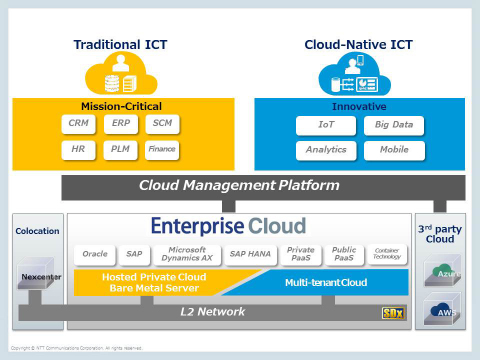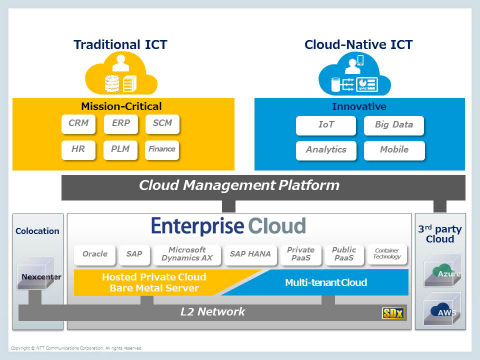TOKYO--(BUSINESS WIRE)--NTT Communications Corporation (NTT Com), the ICT solutions and international communications business within the NTT Group (NYSE:NTT), announced today that it has unveiled dramatic enhancements to its innovative cloud solution, Enterprise Cloud. The enhanced Enterprise Cloud is immediately available in Japan, and will be rolled out in the UK, Singapore, US, Australia, Hong Kong and Germany this year.
NTT Com is launching its enhanced Enterprise Cloud to help enterprises meet the complex requirements of digital transformation — the application of digital technology across multiple aspects of their businesses to unleash creativity, grow faster and maintain market leadership. Their challenge is twofold. On one hand, enterprises are seeking to migrate traditional ICT to the cloud for more effective ICT operations and cost optimization; on the other, driven by mobile, social, big-data, IoT and other digital technologies, they are deploying cloud-native applications and shifting toward a DevOps culture that supports rapid innovation. To meet these challenges, NTT Com's enhanced Enterprise Cloud provides a comprehensive platform for both traditional and cloud- native ICT, as well as network connectivity, colocation service and third-party cloud.
“As enterprise businesses move towards digitalization, globalization and cloud, NTT Com will continue to help customers innovate business processes and create new business models with Enterprise Cloud, which has been enhanced to meet requirements of both secure and reliable ICT and flexible and agile ICT,” said Motoo Tanaka, Senior Vice President of Cloud Services at NTT Com.
New and Enhanced Capabilities:
(1) Hosted Private Cloud for Traditional ICT
Enterprise Cloud’s hosted private cloud now consists of dedicated bare-metal servers with the automation, pay-as-you-go flexibility and options of a multi-hypervisor environment, including VMware vSphere and Microsoft Hyper-V. It also provides a highly flexible internal network, which facilitates the re-use of on-premises network architecture in the cloud. Enterprise customers can realize cloud-enabled traditional ICT by seamlessly migrating to the hosted private cloud any on-premises systems that require a dedicated environment for reasons of performance, security or licensing. Such migrations contribute to the optimization of traditional ICT environments and form a foundation for further cloud-based digital transformation.
(2) Enterprise-class Multi-tenant Cloud for Cloud-Native ICT
The Enterprise Cloud now features a secure and highly reliable, enterprise-class multi-tenant cloud based on the OpenStack architecture, which therefore gives customers an industry-standard open API to control the Enterprise Cloud in an automated manner. In addition, by incorporating Cloud Foundry, an open source Platform-as-a-Service (PaaS) software, the Enterprise Cloud provides PaaS for agile application development and operational efficiency. This gives customers enterprise-class service quality as well as effective management of agile and Dev-Ops oriented application development. The open architecture meanwhile relieves concerns about vendor lock-in and accelerates customers’ digital business strategies.
(3) Seamless Hybrid Cloud Environment
The enhanced Enterprise Cloud’s multi-tenant cloud and hosted private cloud are connected at Layer 2 with SDN, which gives customers the power to flexibly and seamlessly configure the network components (virtual server, bare-metal server, firewall, load balancer) running on a complex on-premises environment in the same network segment. As a result, customers can reduce approximately 30% of the workload required for the network and server re-configuration that usually comes with cloud migration.
(4) Free and Seamless Connection between Cloud Platforms
The enhanced Enterprise Cloud platform is connected with a 10Gbps best-effort closed network, which is free of charge. In addition, connectivity between Enterprise Cloud platforms and data centers is provided at competitive prices globally, utilizing NTT Com’s infrastructure as a telecom carrier. These network capabilities enable enterprises to optimize their ICT systems, for instance by sharing CAD data with regional suppliers or collecting sensor data, as the data transfer and system collaboration on cloud platforms and data centers are easy to use, and either free of charge or low cost. Cloud capabilities like these support digital transformation on a global scale, dramatically improving the performance and reach of enterprises’ global business.
(5) Cloud Management Platform (CMP) for Full Visibility and IT Governance
NTT Com is launching CMP for the efficient management and unified control of both Enterprise Cloud and third-party providers’ clouds, including Amazon Web Services (AWS) and Microsoft Azure. CMP also enables customer management and operation of hybrid clouds and meets the IT governance, cost control, security management and automated ICT operational requirements needed to successfully execute a cloud-first digital transformation strategy companywide.
Future Roadmap
NTT Com will continue to enhance its capabilities such as SDx-enabled unification of cloud, world-class data centers and global network assets. The OpenStack-based micro service architecture of Enterprise Cloud enables NTT Com to incorporate the latest technology advancements coming from both open source communities and its technology partners. Some of the new functions NTT Com plans to launch for enterprises include SAP HANA, virtual private PaaS and enhanced cloud management capabilities, to further support the digital transformation journeys of its enterprise customers.
|
Service List: |
||||
| Category | Service | Description | ||
| Server |
Hosted private cloud
(Bare-metal) |
On-demand, high-performance physical servers suitable for high-quality databases or dedicated licenses for physical servers | ||
|
Hosted private cloud
(Multi-hypervisor environment) |
Reliable hosted private cloud, compatible with VMware vSphere and Microsoft Hyper-V | |||
| Multi-tenant cloud | Competitively priced shared cloud based on OpenStack | |||
| Image data storage | Storage for disk images | |||
| Storage | Block storage | External storage for connection with servers | ||
| Network | Internet connection | Connections to Internet and global IP addresses, either best-effort or reserved-bandwidth | ||
| VPN connection | Connections to NTT Com’s VPN service | |||
| Remote data center connection | Layer 3 connection between remote data centers | |||
| Colocation connection | Layer 2 connection between Enterprise Cloud and nearby colocation data center | |||
| Enterprise Cloud connection | Layer 2 connection between nearby Enterprise Clouds | |||
| Logical network | Network to connect multiple equipment via Layer 2 connection | |||
| Firewall | Firewall via software appliance in virtual server | |||
| Security | Network-hosted security | Network security functions | ||
| Host-based security | Antivirus, virtual patch and firewall functions between hosts | |||
| Solution package | Hyper-V | Dedicated private Microsoft virtual environment (Hyper-V / System Center) | ||
| Management | Monitoring | Monitoring of various resources | ||
| Support | Support for inquiries and accidents | |||
| Cloud Management Platform | Portal site for unified management of multiple cloud platforms, including those of other companies | |||
| App Service | PaaS | Application Dev/Ops environment provided in the multi-tenant cloud | ||
Supporting Quotes:
Melanie Posey, research vice president for IaaS/hosting services at IDC
“The
enhancements to NTT Com’s Enterprise Cloud offer enterprises the type of
comprehensive platform needed for the digital transformation journey,”
said Melanie Posey, research vice president for IaaS/hosting services at
IDC. “Hybrid is the future state of enterprise IT. Enterprise Cloud
accommodates the requirements of both traditional 2nd Platform*1
enterprise applications and agile DevOps-oriented cloud-native 3rd
Platform*2 environments, while NTT Com’s cloud management
platform is positioned to provide unified visibility, management, and
control across the entire hybrid IT stack.”
*1, *2 IDC’s 3rd
Platform concept describes a progression in enterprise IT technology
from the 1st Platform (mainframes), 2nd Platform (static client-server
LAN architectures), and 3rd Platform (dynamic cloud-based IT over the
Internet and wide area networks).
Geoff Waters, vice president, Service Provider Channel at VMware
“The
enhancements to NTT Communication’s Hosted Private Cloud offering
enables organizations to have a seamless transition from an on-premises
environment to the dedicated cloud,” said Geoff Waters, vice president,
Service Provider Channel at VMware. “NTT Communications is a key partner
in our vCloud® Air™ Network cloud provider ecosystem, and these new
features build on a strong foundation of joint solution development and
collaboration with NTT Communications, most recently evidenced with our
recent work together on cloud-native applications using the VMware
Photon™ Platform.”
VMware, vSphere, vCloud, vCloud Air, and Photon
are registered trademarks or trademarks of VMware, Inc. or its
subsidiaries in the United States and other jurisdictions. All other
marks and names mentioned herein may be trademarks of their respective
companies. The use of the word “partner” or “partnership” does not imply
a legal partnership relationship between VMware and any other company.
About NTT Communications Corporation
NTT Communications provides consultancy, architecture, security and cloud services to optimize the information and communications technology (ICT) environments of enterprises. These offerings are backed by the company’s worldwide infrastructure, including the leading global tier-1 IP network, the Arcstar Universal One™ VPN network reaching 196 countries/regions, and over 140 secure data centers worldwide. NTT Communications’ solutions leverage the global resources of NTT Group companies including Dimension Data, NTT DOCOMO and NTT DATA.
www.ntt.com | Twitter@NTT Com | Facebook@NTT Com | LinkedIn@NTT Com
NTT, NTT Communications, and the NTT Communications logo are registered trademarks or trademarks of NIPPON TELEGRAPH AND TELEPHONE CORPORATION and/or its affiliates. All other referenced product names are trademarks of their respective owners. © 2016 NTT Communications




